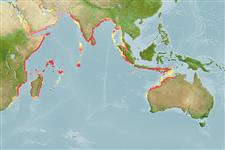Preferred temperature (Ref.
115969): 25.1 - 28.7, mean 27.4 (based on 76 cells).
Phylogenetic diversity index (Ref.
82804): PD
50 = 0.5039 [Uniqueness, from 0.5 = low to 2.0 = high].
Bayesian length-weight: a=0.00794 (0.00454 - 0.01390), b=3.04 (2.89 - 3.19), in cm Total Length, based on LWR estimates for this species & (Sub)family-body (Ref.
93245).
Trophic level (Ref.
69278): 4.0 ±0.62 se; based on food items.
Widerstandsfähigkeit (Ref.
120179): mittel, Verdopplung der Population dauert 1,4 - 4,4 Jahre. (tmax=7; k=0.16-0.7).
Fishing Vulnerability (Ref.
59153): Low to moderate vulnerability (32 of 100).
